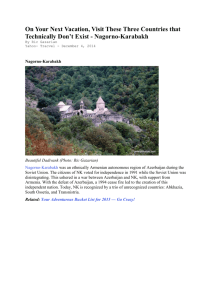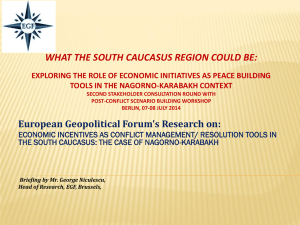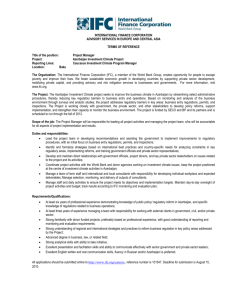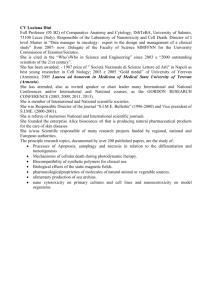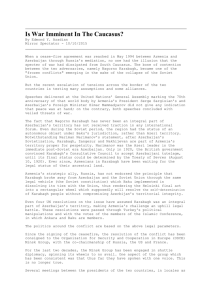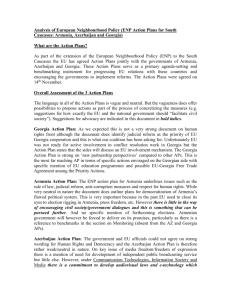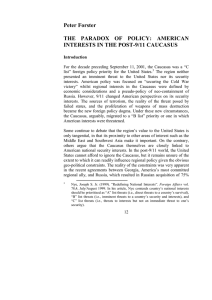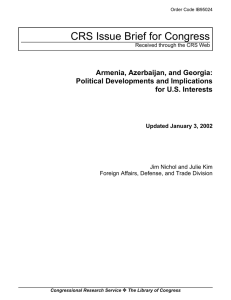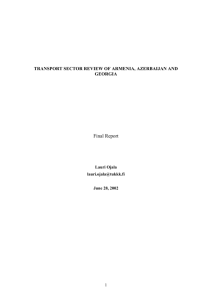Kura-Araks - Transboundary Freshwater Dispute Database
advertisement
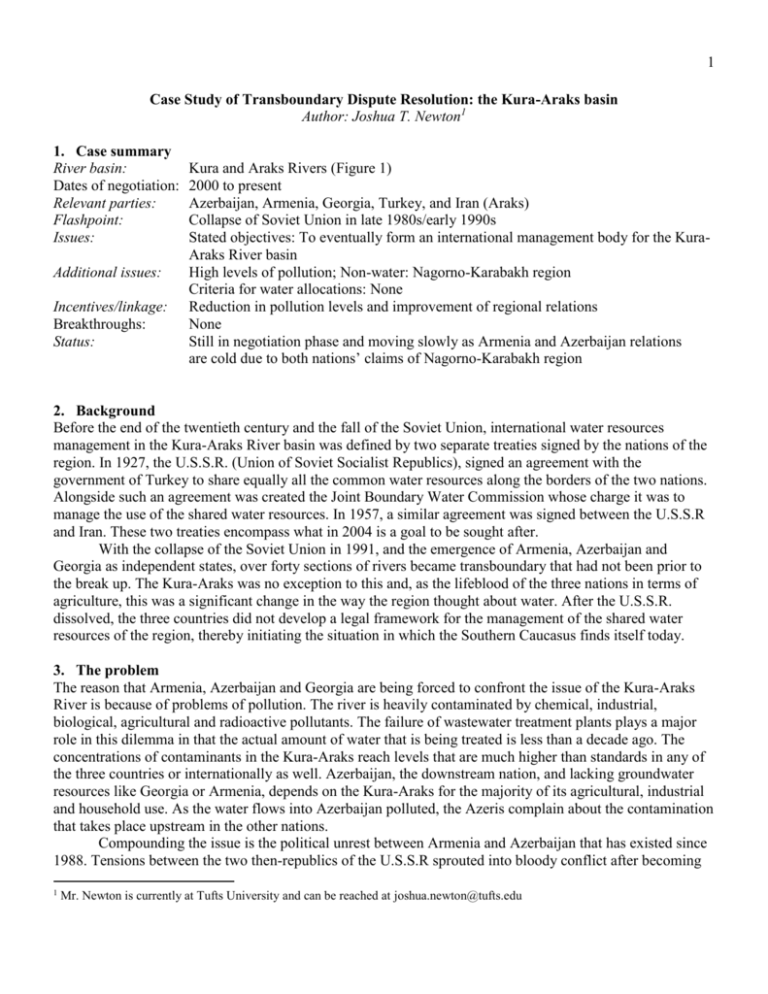
1 Case Study of Transboundary Dispute Resolution: the Kura-Araks basin Author: Joshua T. Newton1 1. Case summary River basin: Dates of negotiation: Relevant parties: Flashpoint: Issues: Additional issues: Incentives/linkage: Breakthroughs: Status: Kura and Araks Rivers (Figure 1) 2000 to present Azerbaijan, Armenia, Georgia, Turkey, and Iran (Araks) Collapse of Soviet Union in late 1980s/early 1990s Stated objectives: To eventually form an international management body for the KuraAraks River basin High levels of pollution; Non-water: Nagorno-Karabakh region Criteria for water allocations: None Reduction in pollution levels and improvement of regional relations None Still in negotiation phase and moving slowly as Armenia and Azerbaijan relations are cold due to both nations’ claims of Nagorno-Karabakh region 2. Background Before the end of the twentieth century and the fall of the Soviet Union, international water resources management in the Kura-Araks River basin was defined by two separate treaties signed by the nations of the region. In 1927, the U.S.S.R. (Union of Soviet Socialist Republics), signed an agreement with the government of Turkey to share equally all the common water resources along the borders of the two nations. Alongside such an agreement was created the Joint Boundary Water Commission whose charge it was to manage the use of the shared water resources. In 1957, a similar agreement was signed between the U.S.S.R and Iran. These two treaties encompass what in 2004 is a goal to be sought after. With the collapse of the Soviet Union in 1991, and the emergence of Armenia, Azerbaijan and Georgia as independent states, over forty sections of rivers became transboundary that had not been prior to the break up. The Kura-Araks was no exception to this and, as the lifeblood of the three nations in terms of agriculture, this was a significant change in the way the region thought about water. After the U.S.S.R. dissolved, the three countries did not develop a legal framework for the management of the shared water resources of the region, thereby initiating the situation in which the Southern Caucasus finds itself today. 3. The problem The reason that Armenia, Azerbaijan and Georgia are being forced to confront the issue of the Kura-Araks River is because of problems of pollution. The river is heavily contaminated by chemical, industrial, biological, agricultural and radioactive pollutants. The failure of wastewater treatment plants plays a major role in this dilemma in that the actual amount of water that is being treated is less than a decade ago. The concentrations of contaminants in the Kura-Araks reach levels that are much higher than standards in any of the three countries or internationally as well. Azerbaijan, the downstream nation, and lacking groundwater resources like Georgia or Armenia, depends on the Kura-Araks for the majority of its agricultural, industrial and household use. As the water flows into Azerbaijan polluted, the Azeris complain about the contamination that takes place upstream in the other nations. Compounding the issue is the political unrest between Armenia and Azerbaijan that has existed since 1988. Tensions between the two then-republics of the U.S.S.R sprouted into bloody conflict after becoming 1 Mr. Newton is currently at Tufts University and can be reached at joshua.newton@tufts.edu 2 Figure 1: Map of the Kura-Araks River Basin. Size: 193,200 km2 (TFDD, 2007). independent nations in 1991 over the Nagorno-Karabakh region, an area embattled with conflict for decades previous. Armenia took over a good portion of the region from Azerbaijan and still controls the region even after a ceasefire took place in 1994. Even ten years later, the issue has not yet been resolved and this has caused major tensions between the two countries with regards to its diplomatic relations and confronting other issues such as the Kura-Araks dilemma. It has been difficult for the two nations to come to the table to talk about the Kura-Araks River when the Nagorno-Karabakh dispute is still underway. 4. Attempts at conflict management Due to the relations between Azerbaijan and Armenia, there has not been any advancement towards a regional entity or treaty that would assist in the cooperation of the management of the Kura-Araks River basin. Many bilateral agreements and laws have been signed between Georgia and Armenia and Georgia and Azerbaijan with regards to regulation of water use and management of both quality and quantity of water resources. There are several international organizations such as UNDP/GEF, USAID and TACIS involved in the region to help with water resources management and development. The progress of such programs has been slow as a result of the tensions between Armenia and Azerbaijan, but a foundation is being established for future work between the nations when they are ready. In 2002, the Regional Environmental Centre for the Caucasus hosted an international conference on “Water Resources Management in the Countries of the South Caucasus in Tbilisi, Georgia between representatives of environmental agencies within the three governments, NGOs, parliamentary committees, scientists, the EU and international organizations and donor agencies. The resolution agreed to by the participants took into consideration the following: Accelerate the reform of the management of water resources Increase the level of involvement and initiatives by the public and by NGOs 3 Develop an environmental security strategy for water resources especially in regards the hazardous material industries of oil, mining and nuclear facilities Develop a regional transboundary water management plan Support a culture of sustainable water use Encourage closer international cooperation in the sustainable use of water resources Improve the coordination and exchange of information between stakeholders These goals, and others, that were agreed to by the participants of the conference are a starting point from which the three nations of the Southern Caucasus can begin to establish good relationships with one another, to build trust in order to develop a regional entity and treaty for the improved management of the Kura-Araks River. 5. Outcome As of yet, there still has been little advancement towards an agreement with regards to the Kura-Araks River. It is thought that as long as there is the issue of the Nagorno-Karabakh region at hand, it will be very difficult for the governments to discuss environmental security when national security is still a major issue. Perhaps through building a more secure environment, with better living conditions and potable water, national security threats might prove to be easier to resolve. 6. Lessons learned Political tensions between countries do not necessarily prevent governments from coming to the table to talk about issues such as management of their transboundary water resources. As a result of the Nagorno-Karabakh issue, the relations between Armenia and Azerbaijan have been cold and neither have been willing to discuss the Kura-Araks problems to a great degree until the land issue has been resolved. With Georgia acting as a mediator between the two nations, this has slowed down the negotiation process to talks concerning the Kura-Araks, but they have moved forward nonetheless. 7. Creative outcomes resulting from resolution process The principle of “parallel unilateralism” was developed here, allowing each collaborating pair of countries to work together, while coordinating the work of the countries which do not. Due to lack of movement from the three primary governments of the Kura-Araks River basin (Armenia, Azerbaijan and Georgia) towards working together in the management of the river, fifty NGOs came together to form the NGO Coalition of the Kura-Araks in order to start activities between the three countries by cleaning up pollution and educating the public about the current situation. 8. Timeline 1927 Turkey and the Union of Soviet Socialist Republics (U.S.S.R) sign the “Treaty on the Beneficial Uses of Boundary Waters” agreeing on a 50%/50% use of all the shared waters between the two nations. A Joint Boundary Water Commission was formed. Aug 1957 Iran and the U.S.S.R sign bilateral agreement over the use of the Araks River waters. Similarily to the 1927 accord, each side is to receive half of the amount of water in the river for irrigation and hydropower generation. 1988 War breaks out between the republics of Armenia and Azerbaijan of the U.S.S.R over religious divide in the region. 1991 Republics of Armenia, Azerbaijan and Georgia become independent nations after the collapse of U.S.S.R. 1994 Ceasefire takes place between countries of Armenia and Azerbaijan. Armenia holds area of 4 Nagorno-Karabakh and many parts of Azerbaijan proper. 1999 Establishment of NGO Coalition of the Kura-Araks, an organization of 50 NGOs from Armenia, Azerbaijan and Georgia which undertakes the clean-up of contamination and raises awareness among communities in the three nations. Jul 2001 First international meeting on the management of the Kura-Araks River basin brings together environmental representatives from the basin governments, NGOs, parliamentary committees, scientists, academics, and international donors. Acknowledgements The map owes its appeal to the cartographic expertise of Sara Ashley Watterson, currently of Earthjustice, and Gretchen Bracher and Nathan Eidem, of Oregon State University. 5 Reference Transboundary Freshwater Dispute Database (TFDD) (2007). Oregon State University. Available on-line at: http://www.transboundarywaters.orst.edu/
